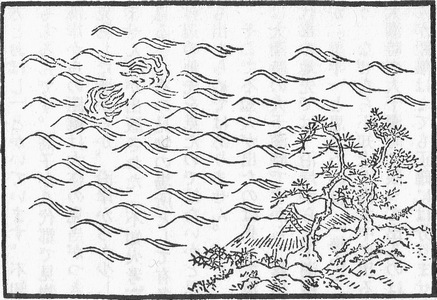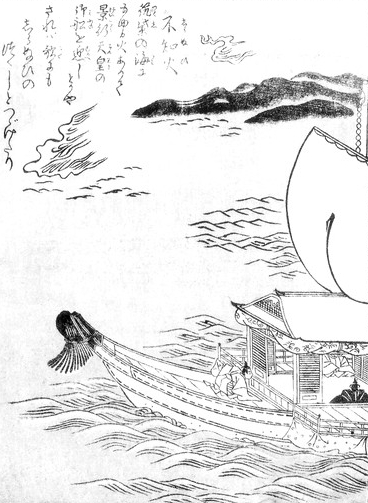Shiranui (other) on:
[Wikipedia]
[Google]
[Amazon]

 is an
is an

 is an
is an atmospheric ghost light Atmospheric ghost lights are lights (or fires) that appear in the atmosphere without an obvious cause. Examples include the onibi, hitodama and will-o'-wisp. They are often seen in humid climates. Tsunoda 1979, pages 11-53
According to legend, some ...
told about in Kyushu
is the third-largest island of Japan's five main islands and the most southerly of the four largest islands ( i.e. excluding Okinawa). In the past, it has been known as , and . The historical regional name referred to Kyushu and its surroun ...
. They are said to appear on days of the noon moon such the (29th or 30th day) of the seventh month of the lunisolar Japanese calendar when the wind is weak, in the Yatsushiro Sea and the Ariake Sea. The phenomenon persists in the present day, with the strange lights having been determined to be an atmospheric optical phenomenon.
Summary
The phenomenon occurs several kilometers out from the shore in open water. First, one or two flames (called "oyabi" (親火, lit. "parent-fire")) will appear. These will split off to the left and right and multiply, eventually producing anywhere from several hundred to several thousand flames in a row. They are said to span four to eight kilometers. It is believed that the greatest number of shiranui can be seen at the lowest tide, within two hours of 3:00AM. They are said to be invisible from the water's surface and visible up to ten meters above the surface. If one attempts to approach them, they will appear to get farther away. They were formerly believed to be the lamps of the Dragon God, and nearby fishing villages would prohibit fishing on days when shiranui were seen. According to the Nihon Shoki, theHizen no Kuni Fudoki
was an old province of Japan in the area of the Saga and Nagasaki prefectures. It was sometimes called , with Higo Province. Hizen bordered on the provinces of Chikuzen and Chikugo. The province was included in Saikaidō. It did not inclu ...
, and the "Higo no Kuni Fudoki", when Emperor Keiko conquered Kumamoto in southern Kyushu, they advanced using the shiranui as a landmark. In his journey to expand the Yamato Ōken, he saw inexplicable spots of moving fire, shiranui, in the Ariake Sea and the Yatsushiro Sea (also called the Shiranui Sea). When he told local gozoku about these sightings, the gozoku replied that they did not know of this fire. It was thus named "shiranu hi" ("unknown fire," which eventually was slurred into "shiranui"), and the area was named , now known as Kumamoto Prefecture.
History
In 1835, Nakashima Hiroashi wrote a book entitled ''On the Shiranui'': From time immemorial, the Gulf of Shimabara, (near Ariake Sea), Japan, has been famed for Shiranui, the unknown fire, which appears from time to time. The phenomenon occurs twice a year, about 30 September and 24 February, from some time after midnight until the approach of dawn. Sometime the light is a large ball of fire rising from the surface of the sea to a height of 60 feet; sometimes it is a line of pale red, fiery globes drifting and down the tide.Hypotheses
# Reflection of star lights # Luminous jellyfish # Fire from undersea active volcano # Light of fishing boats In the Taishō era, Shiranui attracted the attention of many people, including scholars and newspapermen, who attempted to explain the phenomenon scientifically, and have been explained as a type ofmirage
A mirage is a naturally-occurring optical phenomenon in which light rays bend via refraction to produce a displaced image of distant objects or the sky. The word comes to English via the French ''(se) mirer'', from the Latin ''mirari'', meanin ...
. There was a large scale investigation with two ships and more than 50 people in the Ariake Sea in 1916. However, they reported conflicting data and no scientific clarification was reached. According to one theory from the Shōwa era by Machika Miyanishi, professor of Kumamoto Higher Technical School and Hiroshima Higher Technical School, who made extensive scientific studies and wrote eight papers, including two English papers, the time when shiranui appear is the time when the temperature of the sea is the greatest in the year, and the tide would sink about 6 meters, resulting in a mudflat
Mudflats or mud flats, also known as tidal flats or, in Ireland, slob or slobs, are coastal wetlands that form in intertidal areas where sediments have been deposited by tides or rivers. A global analysis published in 2019 suggested that tidal fl ...
and sudden radiative cooling, and overlapping with the land formation at the Yatsushiro Sea and the Ariake Sea, the lights of the boats that would depart to get the fish of the tidelands would get refracted. This theory is seen as having merit even in the modern era, and Miyanishi Machika, of the high industries of Kumoto and a professor from the Hiroshima Higher Technical School, researched this as his specialty. According to him, the shiranui are fires for luring fish at night (''isaribi''), their flickering and their alliance and rupture, helped with optical illusion
Within visual perception, an optical illusion (also called a visual illusion) is an illusion caused by the visual system and characterized by a visual perception, percept that arguably appears to differ from reality. Illusions come in a wide v ...
s, results in it being seen as mysterious flames.
The meteorologist Sakuhei Fujiwhara wrote ''Atmospheric Light Phenomena'' in 1933, but in it, he wrote that he did not know the cause of shiranui, and due to some who profited from delighting sightseers, he pointed out the possibility that they are from noctiluca.
Tairi Yamashita, Professor at Kumamoto University, made extensive studies of Shiranui using modern instruments with the assistance of students. He concluded that "Shiranui is an optical phenomenon resulting from light going through the complicated distributions of clumps of air with different temperatures and getting refracted. Therefore, the source of these lights are fires from private houses and fires used for luring fish, and so on. When these conditions are met, the same kind of phenomenon can be seen in other places and days. For example, road mirage
A mirage is a naturally-occurring optical phenomenon in which light rays bend via refraction to produce a displaced image of distant objects or the sky. The word comes to English via the French ''(se) mirer'', from the Latin ''mirari'', meanin ...
s, mirages in general, and heat shimmer
A mirage is a naturally-occurring optical phenomenon in which light rays bend via refraction to produce a displaced image of distant objects or the sky. The word comes to English via the French ''(se) mirer'', from the Latin ''mirari'', meanin ...
are the same type of phenomena. Also, Nobuyuki Marume, in the collection of essays, "Shiranui," published many photographs under the title "Changes of Shiranui with the Passage of Time from Shiranui Town towards the Direction of Amura."
Machika Miyanishi, professor of Kumamoto Higher Technical School and Hiroshima Higher Technical School, made extensive scientific studies and wrote eight papers, including two English papers. His conclusion was: the light source of Shiranui was that of fishing boats. Large tideland forms lumps of air of different temperatures on special days, and by the voltex movement of air lumps, the light appears as deformed fluctuation in images of light. Tairi Yamashita, Professor at Kumamoto University, made extensive studies of Shiranui using modern instruments with the assistance of students. He concluded that there is a very complex distribution of heated air lumps and cold air lumps which constantly change. Light from distant sources repeatedly fluctuates, and either increases or decreases or disappears. In some cases, light is split. These changes appear to the observer changing greatly and irregularly. Under the same conditions, Shiranui may appear in other seasons.'' A study of Shiranui''. Tairi Yamashita. 1994. Ashi Shobou.
Nowadays, the tidal flats are all filled up, lightbulbs illuminate the darkness of the night, and the seawater has become polluted making it difficult to see these shiranui.
See also
* Hitodama * Kitsunebi * Will-o'-the-wispReferences
Sources
* ''A study of Shiranui''. Miyanishi Machika. Dainippon Shuppan Kabushiki Kaisha. 1943. * ''A collection of references on Shiranui''. Shiranui reference collecting committee. 1993. Shiranui Town. * ''Investigation on Shiranui I''. Tairi Yamashita. Kumamoto University Department of Education Kiyo. Vo. 21 1972. * ''Investigation on Shiranui II'' Tairi Yamashita. Kumamoto University Department of Education Kiyo. Vol. 33, 1984. * ''Changes of Shiranui with the Passage of Time from Shiranui Town towards the Direction of Amura''. Nobuyuki Marume. Photographs, 9th collection. * ''A study of Shiranui''. Tairi Yamashita. 1994. Ashi Shobou. * ''A new study of Shiranui''. Iwao Tateishi.1994. Tsukiji Shokan. {{Japanese folklore long Atmospheric ghost lights Atmospheric optical phenomena History of Kumamoto Prefecture Kumamoto Prefecture Yōkai